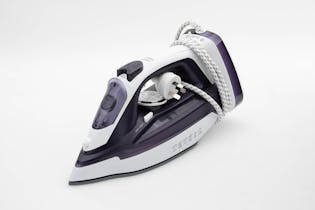Irons and steam stations
De-crease the burden of ironing by checking out our test results and buying guide.
Which can get all your fabrics wrinkle-free? We tested irons and steam stations on a range of fabrics and garments from delicate organza and silk to heavy-duty wool, cotton shirts, denims and linen.
Iron or steam station?
Steam irons

Standard steam irons are the answer if you don’t do a lot of ironing and don’t want to spend much. They use the heat and weight of the ironing plate to stretch the fabric fibres, which retain their shape after cooling. Most have a steam function to aid the process.
- Easy to store.
- Much cheaper than steam stations.
- Require more effort to remove creases than a steam station.
Steam stations

Steam stations have a separate tank with an iron that sits on top. They rely on large volumes of steam to smooth creases, rather than heat. More steam means faster ironing, which makes a steam station a good choice for bigger families – especially those who do a lot of ironing at once.
- Faster than a standard iron.
- Require less effort to remove creases.
- Bulky and awkward to move (they suit a permanent set-up)
- Need a vented ironing board with space for the steam station
- Require good ventilation – our room steamed up during testing
- Should not be used over a precious floor, as the bottom of the board may drip.
- Expensive.
Features to look for
Auto cut-off
- Strongly recommended. If the iron is left lying down, it turns off at around 30 seconds. If it's standing up, it turns off after 2 to 15 minutes.
Soleplates
- A polished aluminium soleplate is used on budget irons, and may become sticky over time.
- A "non-stick" soleplate is easier to keep clean, but be careful not to scratch it on zips or buttons. "Non-stick" is marketed under many names including Teflon, Dynaglide, and Durilium.
- Stainless steel soleplates glide smoothly, but may scratch.
- Ceramic soleplates claim to be durable and scratch-resistant.
Steam
- Drip protection stops the iron steaming if the heat is too low. Without drip protection, using steam at low heat can result in streaks or stains because there’s not enough heat to evaporate the water.
- Variable steam allows for extra oomph on heavy fabrics and less puff on light or sensitive fabrics.
- A shot of steam provides an extra surge that's useful for stubborn creases.
- Vertical steam can restore respectability to a rumpled suit, getting creases out of fabrics too delicate to iron, and avoiding that shiny look from ironing wool and some other fabrics. The steam isn’t continuous, so it can be tedious to do large areas.
Other considerations
- A button groove is a gap between the iron and soleplate that makes it easier to iron around buttons.
-
Self-cleaning removes hard water scale deposits that can clog the steam valve and soleplate holes. (If the inside of your kettle "furs up", you live in a hard water area.)
- The spray function may end up with water where you don't want it. Use a plant mister or spray bottle instead – its aim is more accurate than the iron's and it produces a better result.
- A thermostat light turns off when the preset temperature is reached, while the power-on light warns you that the iron is hot.
- Cord length is important for safety. Plugging directly into the power outlet is safer than using an extension cord.
- Storage is easier if the iron has a "heel" that lets you wrap the cord around it. Some also have a clip to secure the cord.
- Weight. A light iron is easy to move, but needs more downward pressure. A heavier iron needs less pressure but more effort to move and lift. Tip: pick up a display model in the store (or take one out of its box) and check that its weight and balance are right for you.

Looking for a clothes dryer?
Choosing the right clothes dryer pays off in the long run. We’ve tested heat-pump, condenser and vented clothes dryers to find the most efficient, easiest to use and fastest.
We've tested 26 irons and steam stations.
Find the right one for you.
Anko
.jpg&w=315&q=75)
Anko

Braun
.jpg&w=315&q=75)